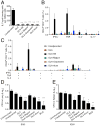Adjuvant formulation structure and composition are critical for the development of an effective vaccine against tuberculosis
- PMID: 23933525
- PMCID: PMC3871206
- DOI: 10.1016/j.jconrel.2013.07.030
Adjuvant formulation structure and composition are critical for the development of an effective vaccine against tuberculosis
Abstract
One third of the world is infected with Mycobacterium tuberculosis (Mtb) with eight million new cases of active tuberculosis (TB) each year. Development of a new vaccine to augment or replace the only approved TB vaccine, BCG, is needed to control this disease. Mtb infection is primarily controlled by TH1 cells through the production of IFN-γ and TNF which activate infected macrophages to kill the bacterium. Here we examine an array of adjuvant formulations containing the TLR4 agonist GLA to identify candidate adjuvants to pair with ID93, a lead TB vaccine antigen, to elicit protective TH1 responses. We evaluate a variety of adjuvant formulations including alum, liposomes, and oil-in-water emulsions to determine how changes in formulation composition alter adjuvant activity. We find that alum and an aqueous nanosuspension of GLA synergize to enhance generation of ID93-specific TH1 responses, whereas neither on their own are effective adjuvants for generation of ID93-specific TH1 responses. For GLA containing oil-in-water emulsions, the selection of the oil component is critical for adjuvant activity, whereas a variety of lipid components may be used in liposomal formulations of GLA. The composition of the liposome formulation of ID93/GLA does alter the magnitude of the TH1 response. These results demonstrate that there are multiple solutions for an effective formulation of a novel TB vaccine candidate that enhances both TH1 generation and protective efficacy.
Keywords: Alum; BCG; Bacillus Calmette–Guérin; GLA; Liposomes; Mtb; Mycobacterium tuberculosis; Oil-in-water emulsions; SE; TB; Vaccine formulation; glucopyranosyl lipid adjuvant; stable emulsion; tuberculosis.
© 2013.
Figures





References
-
- WHO global tuberculosis control report, Summary. Cent Eur J Public Health. 2010;18:237. - PubMed
-
- Andersen P, Doherty TM. The success and failure of BCG — implications for a novel tuberculosis vaccine. Nat Rev Microbiol. 2005;3:656–662. - PubMed
-
- Flynn JL, Chan J. Immunology of tuberculosis. Annu Rev Immunol. 2001;19:93–129. - PubMed
Publication types
MeSH terms
Substances
Grants and funding
LinkOut - more resources
Full Text Sources
Other Literature Sources
Medical

